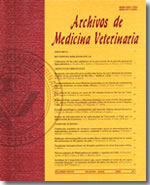Bovine immunodeficiency virus
Main Article Content
Abstract
At present, a considerable amount of knowledge has accumulated about the molecular biology of bovine immunodeficiency-like virus -BIV-. BIV has the most complex genome of the nonprimate lentiviruses and contains a series of accessory genes that are used to positively regulate virus gene expression in a fashion similar to that exhibited by the primate lentiviruses. This similarity in BIV and primate lentivirus accessory gene function may help in efforts to elucidate the role of accessory genes in lentivirus replication and pathogenicity.
BIV infection of cattle does not produce acute clinical diseases in the absence of cofactors, and thus is typical of most other ungulate and simian lentiviruses with reduced pathogenicity, which have naturally evolved during virus-host adaptation. This finding contrasts with more acutely pathogenic lentiviruses, such as SIVpbj and MVV strain K1772. They have recently mutated to forms that induce a rapid clinical disease and a quick death for the host.
In any event, bovine susceptibility to BIV disease may depend upon BIV strains, but also on bovine breeds and environmental factors. It thus will be important to determine the factors that regulate BIV expression and enhance pathogenicity.

